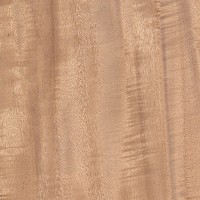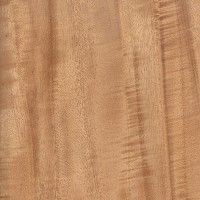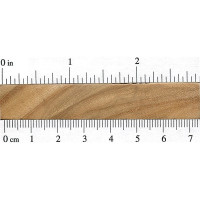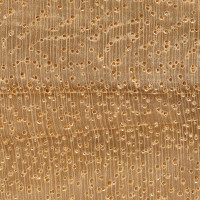 |
Common Name(s): Primavera, Prima Vera Scientific Name: Roseodendron donnell-smithii (syn. Cybistax donnell-smithii, Tabebuia donnell-smithii) Distribution: Central America (Also grown on plantations) Tree Size: 65-100 ft (20-30 m) tall, 2-3 ft (.6-1.0 m) trunk diameter Average Dried Weight: 29 lbs/ft3 (465 kg/m3) Specific Gravity (Basic, 12% MC): .40, .47 Janka Hardness: 710 lbf (3,170 N) Modulus of Rupture: 10,230 lbf/in2 (70.5 MPa) Elastic Modulus: 1,133,000 lbf/in2 (7.81 GPa) Crushing Strength: 5,850 lbf/in2 (40.4 MPa) Shrinkage: Radial: 3.1%, Tangential: 5.1%, Volumetric: 8.6%, T/R Ratio: 1.6 |
Color/Appearance: Usually ranges from a pale cream color to a golden yellow. Color tends to darken and redden with age. Can exhibit a ribbon-like chatoyant grain pattern similar to quartersawn Sapele.
Grain/Texture: Grain usually ranges from straight to slightly interlocked. Medium texture and medium sized pores, with a naturally high luster.
Rot Resistance: Heartwood is somewhat resistant to decay, though it is susceptible to insect attack. Primavera has good overall weathering properties. Also, heartwood and sapwood are not well defined and look similar in color, with the sapwood being perishable.
Workability: Although Primavera frequently has interlocked and irregular grain, it is overall quite easy to work: most likely on account of its rather low density compared to other hardwoods. It does, however, have a moderate blunting effect on cutting edges, so carbide tools are recommended. Primavera also tends to split when nailed or screwed, so pilot holes are recommended despite the wood’s softness. Turns, glues, stains, and finishes well.
Odor: No characteristic odor.
Allergies/Toxicity: Although no known direct testing has been performed, Primavera has been found to contain Lapachenole and Lapachol, two sensitizers found in other wood species that are known to cause skin irritation. See the articles Wood Allergies and Toxicity and Wood Dust Safety for more information.
Pricing/Availability: Primavera is commonly sold in both lumber and veneer form. Prices should be in the mid-range for imported lumber; prices are likely to be stabler than other tropical American exotics since it is also plantation grown.
Sustainability: This wood species is not listed in the CITES Appendices or on the IUCN Red List of Threatened Species.
Common Uses: Veneer, furniture, cabinetry, and interior trim.
Comments: Primavera looks similar to a number of other wood species, such as Ceylon Satinwood, and is sometimes also referred to as “White Mahogany.”
Related Species: None available.
Scans/Pictures: A special thanks to Steve Earis for providing the veneer sample of this wood species.
 |
 |
 |
 |





I am curious about the statement Primavera ages to reddish like the sample photos here. Under what conditions or how much time?
I bought several 2 inch thick planks from a guitar supplier over 3 years ago which were probably milled at least a year before. Three I machined and finished with nitrocellulose lacquer, two I still have in storage. All of them are still the same cream to yellow color without change, with chatoyance that looks great with finish.
Sealed and in a storage unit without direct sunlight or high humidity the original color should hold fast. Do a test with 2 cutoffs. One sealed and one unsealed.
Primavera has some of the most beautiful chatoyance of any hardwood I’ve seen. Most species with similar ribbon-figure have a darker color tone (Koa, Sapele, African Mahogany, Okoume,etc). Maybe it’s the pale white color that makes it look so unique?
Primavera is like the love child of Okoume & Avodire, IMO, If only it were a little more stable & easy to dry..
I have been running a small harvesting and milling operation on the island of Hawaii for about 25 years. I’ve been fortunate enough to harvest two Primavera trees in that time. I think it is one of the finest looking timbers I have sawn yet! This is from someone who cuts a lot of Koa.It has a creamy base color and reddish streaks combined with a beautiful grain pattern, especially when quartersawn. When these trees are in full blossom it’s a sight to behold, especially if it’s an entire grove! I’m going to give propagation of these trees a try,… Read more »
Aloha! I also live in Hawaii. Ive had one of these trees outside my window for 9 years. It’s absolutely stunning. My landlords are about to cut it down. Was wondering if you propagated this tree? And had any success? Going to try to do it myself before they cut it down . Any information you have would be much appreciated! Mahalo!
I lived and woodworked on Oahu many years. In that time I built a set of furniture for a local school in primavera wood. The wood came a primavera tree that had to be felled to make room for their new athletic complex. It was a joy to work with! “Hey” to you, Jay!!
From my limited experience with it, this wood smells of persimmon when being worked. Anyone else notice this?
Jordan;
Here is what primavra looks like. it does not have same grain as african mohogany at all. A very tight and lusterous wood grian will likely not show thru the PBK white wood wash look.